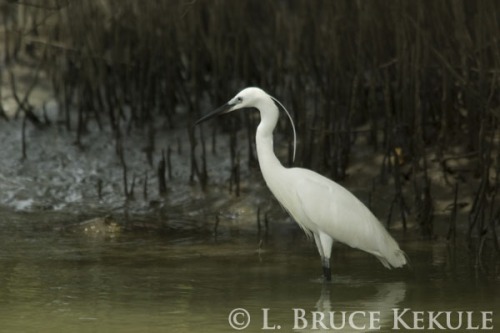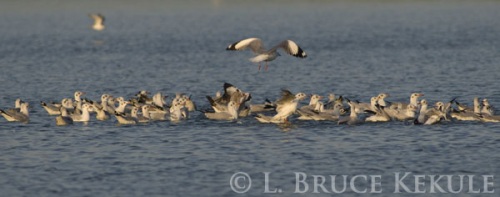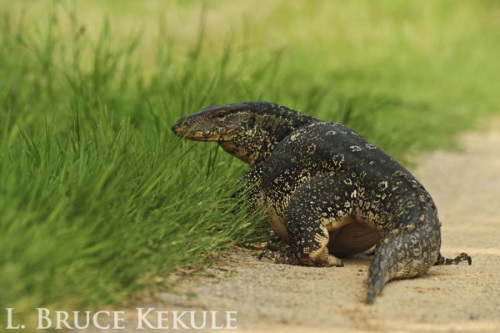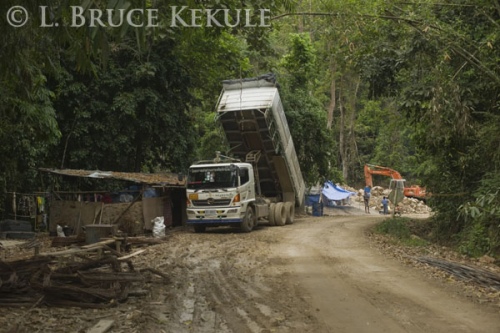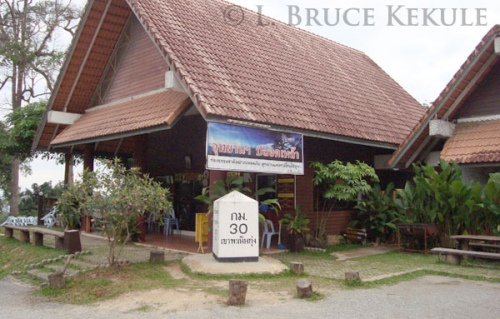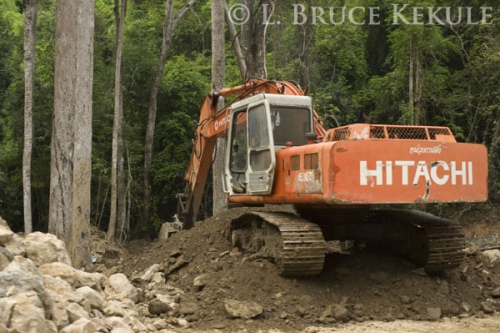Laem Phak Bia Royal Project in Phetchaburi
Bird sanctuary and haven for many species of avian fauna
Laem Phak Bia Environmental Research and Development Project
Pied kingfishers landing in Phetchaburi province
Birds are among nature’s most fascinating creatures. They are the direct descendants of dinosaurs as shown by their detailed anatomy. Archaeopteryx, a 125 myo fossil from a slate quarry in Germany, is the best-known intermediate between toothed dinosaurs and modern birds, but a rich fossil of feathered dinosaurs has since been uncovered by Chinese researchers. The ancestors of modern birds were adaptable enough to survive the great extinction 65 million years ago that wiped out the rest of the dinosaur assemblage.
Indian skimmer in salt pans next to Laem Phak Bia
At last count, c. 1000 birds had been recorded in the Kingdom of Thailand. Although some, such as the Giant Ibis and Sarus Crane, have been lost due to hunting and habitat destruction, the continued richness and accessibility of Thailand’s birds and birdwatching sites makes the country a magnet for birders and photographers from around the world.
Indian pond-heron in Laem Phak Bia
One of the best-known birdwatching areas lies in Ban Laem district of Phetchaburi, on the coast of the Gulf of Thailand. It includes the Laem Phak Bia Environmental Research and Development Project, established in 1991, and fully operational by 1995.
Painted stork in Laem Phak Bia
H. M. King Bhumipol Adulyadej initiated the project to treat both wastewater and solid waste through environmentally and ecologically sustainable methods. From a pumping station in Phetchaburi city 18.5 km away, wastewater is fed to Laem Phak Bia through a pipeline. This has created a 1 sq. km freshwater oasis among the surrounding expanse of brackish saltpans. The nutrient input makes this a rich feeding area for water birds and insectivorous land birds, including many that are migrants from northern Asia, together with some other animals such as monitor lizard.
Grey heron in Laem Phak Bia
Laem Pha Bia takes its name from a 3 km ‘sand-spit’ that juts into the gulf. This landform is a meeting point for birds, mammals, reptiles and fish from both sheltered mudflats and mangrove habitat of the Inner Gulf and those inhabiting the exposed sand-beaches of the southern Thai peninsula. The project area includes extensive secondary, regenerating, low stature mangrove forest along its coastal margin.
Little egret and mud-skipper in Phetchaburi
The freshwater lagoons, salt and brackish water expanses, mudflats, sand beaches, marsh grasses, and mangroves, plus the garden and tree plantations around the offices at Laem Phak Bia together constitute an unparalleled diversity of habitats in a small area. In turn, this attracts the highest diversity of birds of any place on the gulf shoreline.
Black-capped night-heron in Laem Phak Bia
From 1999 onwards Philip D. Round, Thailand’s most experienced ornithologist, and others have studied the life-cycles and populations of birds in the project. Such dedication by both professional and amateur birders has made Laem Phak Bia a de facto “bird observatory”, like those in Australia, N Europe and N America. A book, ‘Birds of Laem Phak Bia’, published with support from the Chaipattana Foundation in August 2009, is available from bookshops and at the Royal Project for those interested in learning more about the biodiversity of the site.
Great egret breeding nearby at Ban Laem town
Among the 242 species of bird recorded from the project and surrounding areas one of the most outstanding was an Indian Skimmer that arrived to delight bird watchers and photographers in April 2004. Another scarce visitor was an Indian Pond Heron that showed up on the freshwater ponds in 2006. I was fortunate to photograph both these birds during their short stays.
Brown seagulls in a freshwater pond in Laem Phak Bia
In March 2006 a rare and virtually unknown vagrant bird, the Large-billed Reed Warbler, was also netted and banded inside the project area before being photographed and released. At the time the only previous record in the whole world for this species was from the Sutlej Valley, Northwest India back in 1867. Such an amazing discovery shows both the significance of the project, and the continued conservation importance of the Thai Gulf.
Sunset at Laem Phak Bia
Without doubt, the highly successful Laem Phak Bia Environmental Research and Development Project has not only helped the people of Phetchaburi province by reducing pollution, but also provided nature lovers, bird watchers and photographers a chance to get close to some of Thailand’s remarkable endangered birds and eco-systems. This, of course, is a plus for wildlife conservation, and an example how protection and the safety of wild creatures is enhanced by a Royal Project.
Water monitor or locally known as the ‘Water Dragon’
***************************************************************************************************
Notes on Laem Phak Bia by Phillip D. Round
I was immediately struck by the potential of Laem Phak Bia for studying a huge diversity of both resident and migratory birds when first introduced to the site in March 1999. I also fell in love with the tranquility and remoteness of the nearby coastline. Since that time I have spent as many weekends as I can manage there. In collaboration with the Wildlife Research Division of the Department of National Parks, and with the full support and encouragement of the Environmental Research and Development Project director and staff, I my students, and Bird Conservation Society of Thailand helpers, erect mist-nets in order to catch wild birds. These are then marked with a numbered metal band provided by the department; carefully examined, photographed and released.
Collared kingfisher with a bird band by P.D. Round
The long-legged and highly migratory shorebirds are additionally marked with coloured leg-flags that enables their country of marking to be recognized by an observer using binoculars or telescope. Birds marked at Laem Phak Bia have been found as far afield as Australia and NE China.
Black-winged stilt in Laem Phak Bia
But even the resident (non-migratory) birds are of enormous interest. Any bird that bears a numbered metal band is effectively carrying an individual identity card throughout its life — essential for detailed ecological study. Who would have guessed that our longest-lived bird was a diminutive (less than 8 g weight) nok krachip (Common Tailorbird) banded as long ago as 2001! Not only have we learnt much about the life-histories, movements and annual cycles of birds, but we have also taught students the safe bird-handling skills they need to run their own research projects elsewhere in Thailand.
Philip Round is an Assistant Professor in the Department of Biology, Mahidol University, and is also the region al representative of The Wetland Trust (UK).
****************************************************************************************************
COMMENT: Over-development in Kaeng Krachan National Park
Since the cover story was about birds, a report on the other famous bird-watching site in Phetchaburi is called for. Kaeng Krachan National Park is one of Thailand’s most important protected areas for wildlife conservation. The dry-evergreen forest is habitat to more than 400-recorded species including the rare Ratchet-tailed treepie found only in northern Vietnam and Kaeng Krachan.
Ten-wheeled dump truck and backhoe at kilometer 18 in Kaeng Krachan
Last year, several expansion projects were introduced into the park including tree clearing, camp area expansion and construction work were undertaken at several locations including the headquarters area, plus Ban Krang and Phanern Thung ranger stations situated in the interior. Bird watchers and photographers from around the world come regularly to see and photograph the birds, animals and these forest ecosystems.
Her Majesty Queen Sirikit visited Phanern Thung and her palace is maintained past the station. Campgrounds and parking areas have now been expanded into every empty space to increase visitors. A roast chicken and ‘som tam’ restaurant is now open every day at the top.
Chicken shop at Phanern Thung ranger station
About 20 years ago when the road into the park was extended past Phanern Thung to a car park at kilometer 36, a new tourist trap was established known as the ‘Sea of Fog’. Then, some professors at Kasetsart University walked down to the Phetchaburi River along a very tough track and set-up camp for extended stay building bamboo furniture and shacks by the waterway known as ‘KU Camp’.
Now, an even more complex VIP bungalow with tables and seats plus two toilets has been erected here, and recently used by some big shots with a campfire, armrests and drink-holders to boot. The trail down to the river is now widened to accommodate rafting crews and one could almost drive down.
Backhoe digging a huge hole to build a water holding tank
And finally the worst: at kilometer 18, a 10-wheeled truck is parked and a big backhoe is digging an enormous hole, supposedly to build a water storage tank. One of the best bird sites in Kaeng Krachan constantly visited by nature lovers is now completely destroyed by heavy equipment working everyday seen in the accompanying photograph.
Also, a natural stream crosses the road past Ban Krang at three locations but are now covered over with pipes and dirt to accommodate cars and two-wheeled traffic. By the look of things, more construction projects will be on the drawing boards to expand visitation even more. It is doubtful if any feasibility studies have been carried out on the impact of all this construction and destruction of natural tranquility.
After visiting and working in Kaeng Krachan for more than a decade, and knowing how important and beautiful this forest truly is, I feel sadden by all this over-development. It is only the beginning but quickly destroying the park to the point of no return, much like Khao Yai National Park in the Northeast. It is hope someone will read this and go see for themselves what has transpired. Action should be taken by the ‘powers to be’ to ensure anymore degradation is stopped before it is too late!







